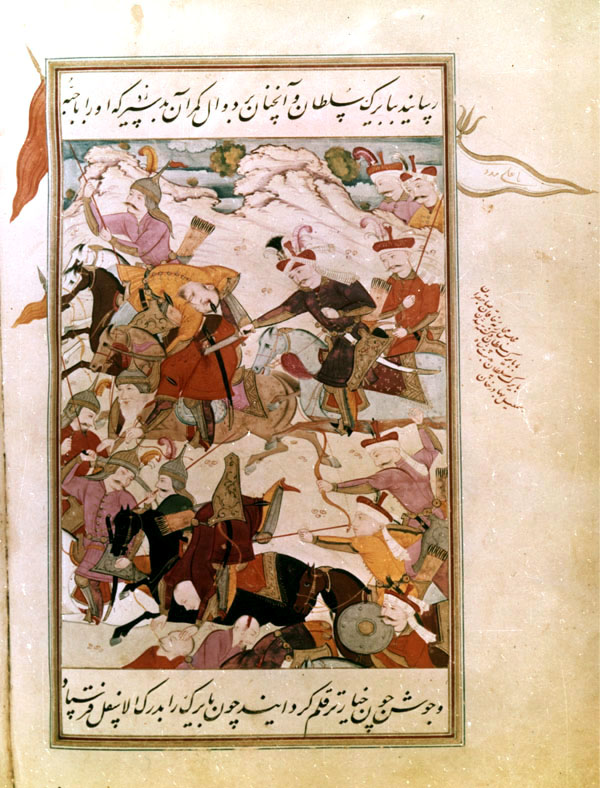)
Qarā Ḵān (?̥) Kills Bāyrak Solṭān
This painting is problematic in several respects. Firstly, the subject is listed in the Mahboubian Catalog as Shah Esmāʿil Killing Bāyrak Solṭān, an identification presumably derived from the red marginal inscription. Secondly, it is listed as appearing on folio 94. The accompanying text, which begins in the middle of a sentence, speaks of Bāyrak Solṭān being sliced like a fresh cucumber, but the name of the person doing the slicing unfortunately appears on the preceding page. Bāyrak Solṭān was the governor of Baghdad, who was unseated from power by Esmāʿil in 908/1503 and fled to Aleppo, according to Eskandar Monshi. Muntazar’s text states that Bāyrak fled when the tide of battle turned against him, but he and Esmāʿil never faced each other in battle, and as much as the shah would have liked to kill him, never had the opportunity. The location in Muntazar’s text conforms to the dating advanced by Monshi, yet folio 94v in this text follows by seven folios an event that can be pinpointed to 913/1507-8 (cf. folio 87). It would seem that either these two pages were mis-cataloged by Mahboubian, or the two pages were inverted when the Tehran manuscript was rebound. In order to resolve these issues one needs access to the complete Tehran text. An additional dichotomy is evident in the painting itself. The Safavid killing Bāyrak Solṭān, identified by marginal inscription as Shah Esmāʿil, is shown wearing purple garments while in all other paintings the shah is portrayed in a white uniform. A similar misrepresentation is also evident in the painting on folio 87, where the main figure is identified by inscription as Esmāʿil but the supportive evidence indicates that it is someone else.
The composition is basically circular with a quilting of overlapping dark forms that comprise the clothing, horses, and weapons, set against a light off-white hillside. A fierce battle is taking place with the participants brandishing swords, lances, bows and arrows. The vanquished are heaped at the bottom, while others are tumbling from their mounts. The principal Safavid personage, questionably identified by inscription as Shah Esmāʿil, dressed in a purple coat and riding the same gray steed as Qarā Ḵān in folio 87, lunges forward to thrust a sword through his opponent Bāyrak Solṭān (correctly identified by the inscription on his shoulder), who slumps forward from his horse. Altogether seventeen figures (seven Safavids, seven opponents, and three bodies) and seven horses are depicted in the composition, including two qezelbāš observers who peer at the event from over the hilltop at the upper right. A touch of blue sky can be seen at the top, along with a slight suggestion of shrubbery. Horses and clothing provide a thick quilting of vermillion, mauve, light orange, brown, black, white and beige.
Location: Reza Abbasi Museum, Tehran, No.77.1.7, folio 94 (?).
Folio size: 35.6 x 21.6 cm. wide (after Mahboubian)
Painting: 21.3 x 20.3 cm. (after Mahboubian; dimensions given apparetly include extensions into the margins).
Written surface: 22.5 cm. (scaled) x 13.1 cm. wide.
Inscriptions: A marginal inscription in red describes the event. Inscriptions are also written on two of figures, identifying one as Bāyrak Solṭān, and incorrectly identifying another as Shah Esmāʿil.
Painting references:
Mahboubian_1972, #923 folio 94v (not illustrated).
Text References:
See Muntaẓer-Ṣāḥeb_1970, pp.160-64 for this event in the History of Shah Esmāʿil.
See Savory, SA_1979, p.55 for this event in the History of Shah ʿĀbbās.
Robert Eng
Last Updated: Nov. 17, 2011 | Previous update: Dec. 8, 2010 | Originally published: April 4, 2002
